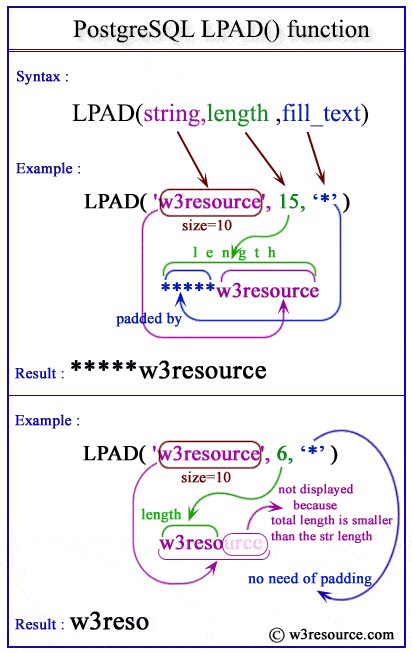PostgreSQL LPAD() function
LPAD() function
The PostgreSQL LPAD() function is used to pad the left side of a string with a specified substring until the string reaches a desired length. If the length of the substring is equal to the remaining length of main string it will fill up properly, if less than the remaining length, the substring will repeat until it is not filling up, if longer than the remaining length or specified length it will be truncated on the right. This function is helpful for formatting and aligning text data.
Uses of LPAD() Function
- String Formatting: Align text to a specific width by padding with a repeated substring.
- Data Presentation: Ensure that data fields have a consistent length for reporting purposes.
- Padding Numbers: Format numerical values to a fixed width by padding with zeros or other characters.
- Data Transformation: Prepare data for integration with systems requiring fixed-length fields.
Syntax:
lpad(string,length[,fill_text])
Parameters:
| Name | Description | Return Type |
|---|---|---|
| string | A string, which will be filled up by another string. | text |
| length | The length of the string, which will be after filled up by substring.. | integer |
| fill_text | The substring which will be fill up the sting to length. | text |
PostgreSQL Version: 9.3
Pictorial Presentation of PostgreSQL LPAD() function
Example: PostgreSQL lpad() function:
In the example below, the main string is 'esource' and its length is 7, the substring is 'w3r' of length 3 and the string have to be a length of 10. So, remaining length is 3, and the substring 'w3r' will fill up properly and the result is 'w3resource'.
SQL Code:
SELECT lpad('esource', 10, 'w3r');
Output:
lpad
------------
w3resource
(1 row)
Example 2:
In the example below, the main string is 'esource' and its length is 7, the substring is 'w3r' of length 3 and the string have to be a length of 13. So, remaining length is 6, and the substring 'w3r' will repeat two times to fill it up, thus the result is 'w3rw3resource'.
SQL Code:
SELECT lpad('esource', 13, 'w3r');
Output:
lpad
---------------
w3rw3resource
(1 row)
Example 3:
In the example below, the main string is 'w3resource' and its length is 10, the substring is 'lpad' of length 4 and the string have to be a length of 8. Here, the specified length is smaller than the string, so, instead of lpadding the string will be truncated by two characters from the right side of the string, thus the result is 'w3resour'.
SQL Code:
SELECT lpad('w3resource', 8, 'lpad');
Output:
lpad ---------- w3resour (1 row)
Previous: LENGTH function
Next: LTRIM function

